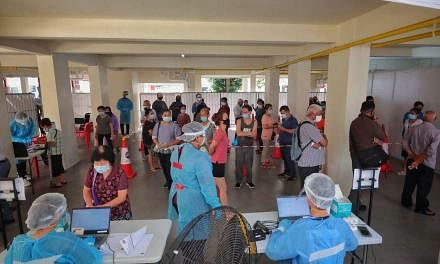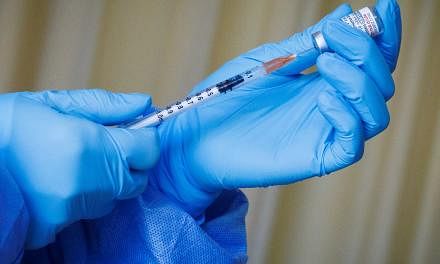There have been over seven million recorded fatalities due to Covid-19, from the beginning of the pandemic until the end of 2023, according to official data, but the actual death toll from the disease may be closer to 21 million, the World Health Organisation (WHO) has said.
And while the coronavirus may no longer be of concern to most people, there are those who continue to suffer silently from long-term impacts.
The WHO is in the process of conducting an analysis of excess deaths during the pandemic, as well as after the disease ceased to be a global health emergency.
Excess deaths are calculated based on the difference between observed deaths in a specific time frame and the expected number of deaths for that same period.
“We are working to estimate what this is. We have estimates up to the end of 2021, and these are being revised to look at excess deaths for 2022 – and will be done for 2023 as well,” said WHO’s Covid-19 technical lead and director ad interim for Epidemic and Pandemic Preparedness and Prevention, Dr Maria Van Kerkhove, at a virtual press conference on Jan 12. “We expect that the actual true number is at least three times higher.”
At the height of the pandemic, countries such as India and China were accused of falsifying Covid-19 data, ostensibly to maintain their international reputations.
Reports of overflowing mortuaries and, in the case of India, bodies being burnt in hospital car parking lots and on the banks of the River Ganges raised doubts about the true toll.
The actual number of infections caused by the virus is also subject to speculation. On paper, at least, the world has seen over 712 million cases of Covid-19 since the first outbreak in the city of Wuhan, China, in December 2019.
The WHO began keeping records of Covid-19 cases and fatalities from January 2020.
But Dr Van Kerkhove said the reported numbers were likely just the tip of the iceberg.
“Case-based data, as reported to WHO, is not a reliable indicator. It has not been a reliable indicator for a couple of years now. And so if you look at the epi curve, it looks like the virus is gone, and it’s not,” she said.
The epi curve – or epidemic curve – is a bar chart that shows the distribution of cases over time.
“According to wastewater estimates that we have from a number of countries, the actual circulation of Sars-CoV-2 is anywhere between two and 19 times higher than what is being reported,” Dr Van Kerkhove added.
As at Jan 14, Russia, Singapore and Italy were the nations reporting the highest number of Covid-19 cases in the preceding 28 days. Globally, a total of 941,265 cases were reported during the period.
But the United States, where 6,100 people died of Covid-19 in the 28 days leading up to Jan 14, does not even figure in the top 10 countries reporting the most cases.
Globally, 10,000 deaths from Covid-19 were reported in December 2023.
“We are missing deaths from around the world. Because countries aren’t reporting deaths, it doesn’t mean that they’re not happening,” said Dr Van Kerkhove, adding that there had been a 42 per cent increase in hospitalisations and a 62 per cent rise in ICU admissions in December 2023.
Under-reporting cases of Covid-19 – and deaths from it – amid a spurt in infections worldwide could be of concern, particularly in terms of capturing important data that would help the health authorities make the right call in case a need arose. It also complicates the job of health experts, for instance, when it comes to measuring the case fatality rate (CFR) – confirmed Covid-19 deaths as a proportion of all confirmed cases.
According to WHO data, the CFR for Covid-19 shot up to about 0.9 per cent in 2023 after falling to 0.28 per cent in 2022. In the first year of the pandemic – 2020 – it stood at 2.4 per cent of all reported cases.
But Professor Dale Fisher, the group chief of medicine at Singapore’s National University Health System (NUHS), pointed out that while it might appear as though a greater percentage of people were again succumbing to Covid-19, this was not the case.
“The mortality rate is the number of deaths divided by the number of cases. So that rate can go up because the denominator is wrong, and we know many people with Covid-19 do not test, and if they do a home test, they do not have it reported. It’s likely the rate captures all the deaths, but not the cases or who stays home,” he said.
Dr Shawn Vasoo, clinical director at Singapore’s National Centre for Infectious Diseases (NCID), said the rates of death estimates were dynamic, and the numbers may vary by time of year and region, as well as by sub-populations.
It is also important to look at the specific mortality metric perused, said Dr Vasoo, noting that the CFR may be very difficult to measure, and measure accurately, due to under-testing for and under-reporting of Covid-19 infections.
Prof Fisher said the current spike in Covid-19 infections and deaths reported globally is commonly seen in infectious diseases, noting that as immunity wanes, there will be more cases, which will consequently result in more deaths.
“Immunity wanes when there are not so many infections around to create natural immunity, as well as less vaccine uptake because the emergency is over. Endemic Covid-19 will continue to come in waves typically lasting around six weeks. It may be seasonal, but it’s too early to tell,” said Prof Fisher.
“Also, the virus that causes Covid-19 is constantly undergoing minor changes, which will also gradually affect one’s immunity.”
Dr Vasoo said there were several factors for the recent surge. “Most importantly, this was driven by the emergence of a new variant, JN.1. Other factors include the waning immunity in populations – which can result from not getting the updated Covid-19 vaccine – as well as increased travel and gatherings.”
Prof Fisher said vaccines designed to combat earlier strains lose effectiveness as the virus mutates.
He said that vaccines were recommended for the vulnerable, particularly seniors and those whose immune system is compromised or those who suffer from chronic diseases. Outcomes for those who get Covid-19 are better if they have been vaccinated in the last six to 12 months, he added.

Dr Vasoo said there is a danger that a variant may emerge that evades immunity generated by previous vaccinations or infections. “Keeping vaccinations up to date would be essential for vulnerable individuals to keep severe Covid-19 at bay,” he added.
Associate Professor Barnaby Young, the head of NCID’s Singapore Infectious Disease Clinical Research Network, noted that long Covid – signs, symptoms and conditions that continue or develop after acute Covid-19 infection – remains a challenge for health experts.
“It remains a difficult syndrome to pin down, with no simple diagnostic test and no simple treatment,” said Prof Young.
Long Covid is more common and severe among individuals who have no immunity to Sars-CoV-2 when they were infected. Nevertheless, booster vaccinations and infections are building up people’s immunity and reducing the risk of long Covid, he added.
Dr Van Kerkhove said that most people with long Covid will recover after four to 12 months, but there are still some people dealing with these long-term impacts for even longer than a year. “We do not have the treatments available yet because it’s still so new. There’s a lot of work that’s ongoing. This is not in someone’s head. This is actually a real condition that needs to be studied properly,” she said.












